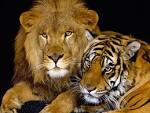Source(google.com.pk)
Childrens Animal Wallpaper Biography
The African plains exhibit at North Carolina Zoo illustrates the dimension of an open-range zoo.
The position of most modern zoos in Australasia, Europe, and North America, particularly those with scientific societies, is that they display wild animals primarily for the conservation of endangered species, as well as for research purposes and education, and secondarily for the entertainment of visitors,[25][26] an argument disputed by critics. The Zoological Society of London states in its charter that its aim is "the advancement of Zoology and Animal Physiology and the introduction of new and curious subjects of the Animal Kingdom." It maintains two research institutes, the Nuffield Institute of Comparative Medicine and the Wellcome Institute of Comparative Physiology. In the U.S., the Penrose Research Laboratory of the Philadelphia Zoo focuses on the study of comparative pathology.[2] The World Association of Zoos and Aquariums produced its first conservation strategy in 1993, and in November 2004, it adopted a new strategy that sets out the aims and mission of zoological gardens of the 21st century.[27]
The breeding of endangered species is coordinated by cooperative breeding programmes containing international studbooks and coordinators, who evaluate the roles of individual animals and institutions from a global or regional perspective, and there are regional programmes all over the world for the conservation of endangered species.[28]
The animal rights organization People for the Ethical Treatment of Animals (PETA) and the anti-zoo campaign group Captive Animals Protection Society argue against the position of the zoos that their main purpose is to undertake research and aid in conservation, alleging that most zoo research is geared toward finding new ways to breed and maintain animals in captivity.[29] Andrew Linzey, director of the Oxford Centre for Animal Ethics, argues that zoos make a "minuscule contribution to conservation."[30]
[edit]Surplus animals
This chimpanzee was passed around five zoos before arriving in a Texas roadside zoo at the age of 37.[31]
For every animal caught in the wild, several more are killed in the process. Therefore, the breeding of animals within zoos is encouraged.[24] Eric Baratay and Elisabeth Hardouin-Fugier of the Université Jean-Moulin, Lyon, say that the overall "stock turnover" of animals is one-fifth to one-fourth over the course of a year—with three-quarters of apes dying in captivity within the first twenty months. They say that the high mortality rate is the reason for the "massive scale of importations."[32]
The downside to breeding the animals in captivity is that thousands of them are placed on "surplus lists" each year, and sold to circuses, animal merchants, auctions, pet owners, and game farms. The San Jose Mercury News conducted a two-year study that suggested of the 19,361 mammals that left accredited zoos in the U.S. between 1992 and 1998, 7,420 (38 percent) went to dealers, auctions, hunting ranches, unaccredited zoos and individuals, and game farms.[33]
Zoos have advertised surplus animals in the Animal Finders' Guide, a newsletter in which the owners of hunting ranches post notices of sales and auctions.[34] Matthew Scully writes that many hunters prefer killing animals from zoos because they make better-looking trophies; the mane of a zoo lion will tend to be cleaner than that of a wild lion.[34] In one case, a zoo owner named William Hampton was found to have been buying animals and systematically slaughtering them in order to sell their skins, heads, and pelts as trophies.[35]
Animals that breed may be killed for their meat; Nuremberg zoo's deputy director, Helmut Mägdefrau, has said, "If we cannot find good homes for the animals, we kill them and use them as feed."[36] Other animals may be sold to smaller zoos with poor conditions. PETA cites the example of Edith, a chimpanzee found in a concrete pit in a roadside zoo called the Amarillo Wildlife Refuge in Texas. She had been born in the Saint Louis Zoo, but had been sold just after her third birthday, and for the next 37 years was passed around five other facilities before landing in the roadside zoo.[37]
It was alleged in March 2008 that hundreds of the Berlin Zoo's 23,000 animals are missing, amid allegations that they have been slaughtered, and that some tigers and leopards were sent to China to make drugs for traditional Chinese medicine. Claudia Hämmerling, a Green Party politician, said she had evidence that four Asian black bears and a hippopotamus were taken from Berlin to go to a new home, but were transported instead to Wortel in Belgium, which The Guardian reports has no zoo, but does have a slaughterhouse. The zoo's director, Bernhard Blaszkiewitz, replied that the allegations were "untruths, half-truths and lies."[36]
[edit]Condition of the animals
A sick macaque in the Zigong People's Park Zoo, Sichuan, China. [1]
Sea lions at the Melbourne Zoo
The condition of the animals varies widely, especially in zoos in countries with little or no regulations. The majority of the large non-profit and scientifically oriented institutions are working to improve their animal enclosures, although constraints like size and expense make it difficult to create ideal captive environments for some species, such as dolphins and whales.[38][39]
The bear cages, one square meter in size, in Dalian zoo, Port Arthur, Liaoning Province, China, in 1997.
Some critics argue that animals that live in zoos are treated as voyeuristic objects rather than living creatures, and are often driven to insanity in the transition from being free and wild to incarcerated and dependent on humans for survival.[40]
A four-decade Oxford University study found that polar bears, lions, tigers, and cheetahs show the most evidence of stress in captivity.[41][42] A PETA investigation of zoos in the U.S. found that several bear species were engaging in neurotic, stereotypical behavior, including pacing, walking in circles, and swaying or rolling their heads.[43] The Badaltearing Safari Park in China keeps a pair of moon bears in cages so small that they are unable to turn around. The Daily Mail reported in January 2008 that one of them appeared to have gone insane and spends its time shaking its head and banging into the sides of the cage.[44]
[edit]Live feeding
In the Badaltearing Safari Park in China, zoo visitors can throw live goats into the lions' enclosure and watch them being eaten, or can purchase live chickens tied to bamboo rods for the equivalent of 2 dollars\euros to dangle into lion pens. Visitors can drive through the lion's compound on buses with specially designed chutes leading into the enclosure into which they can push live chickens. In the Xiongsen Bear and Tiger Mountain Village near Guilin in south-east China, live cows and pigs are thrown to tigers to amuse visitors.[44][45] In the Qingdao zoo, visitors engage in "tortoise baiting", where tortoises are kept inside small rooms with elastic bands round their necks, so that they are unable to retract their heads. Visitors then throw coins at them. The marketing claim is that if you hit one of them on the head and make a wish, it will be fulfilled.[44]
[edit]Regulation of zoos
[edit]United States of America
In the United States, any public animal exhibit must be licensed and inspected by the United States Department of Agriculture, United States Environmental Protection Agency, Drug Enforcement Administration, Occupational Safety and Health Administration, and others. Depending on the animals they exhibit, the activities of zoos are regulated by laws including the Endangered Species Act, the Animal Welfare Act, the Migratory Bird Treaty Act of 1918 and others.[46] Additionally, zoos in North America may choose to pursue accreditation by the Association of Zoos and Aquariums (AZA). To achieve accreditation, a zoo must pass an application and inspection process and meet or exceed the AZA's standards for animal health and welfare, fundraising, zoo staffing, and involvement in global conservation efforts. Inspection is performed by three experts (typically one veterinarian, one expert in animal care, and one expert in zoo management and operations) and then reviewed by a panel of twelve experts before accreditation is awarded. This accreditation process is repeated once every five years. The AZA estimates that there are approximately 2,400 animal exhibits operating under USDA license as of February 2007; fewer than 10% are accredited.[47]
[edit]Europe
In April 1999, the European Union introduced a directive to strengthen the conservation role of zoos, making it a statutory requirement that they participate in conservation and education, and requiring all member states to set up systems for their licensing and inspection.[48] Zoos are regulated in the UK by the Zoo Licensing Act of 1981, which came into force in 1984. A zoo is defined as any "establishment where wild animals are kept for exhibition ... to which members of the public have access, with or without charge for admission, seven or more days in any period of twelve consecutive months," excluding circuses and pet shops. The Act requires that all zoos be inspected and licensed, and that animals kept in enclosures are provided with a suitable environment in which they can express most normal behavior.[48]










Childrens Animal Wallpaper Biography
The African plains exhibit at North Carolina Zoo illustrates the dimension of an open-range zoo.
The position of most modern zoos in Australasia, Europe, and North America, particularly those with scientific societies, is that they display wild animals primarily for the conservation of endangered species, as well as for research purposes and education, and secondarily for the entertainment of visitors,[25][26] an argument disputed by critics. The Zoological Society of London states in its charter that its aim is "the advancement of Zoology and Animal Physiology and the introduction of new and curious subjects of the Animal Kingdom." It maintains two research institutes, the Nuffield Institute of Comparative Medicine and the Wellcome Institute of Comparative Physiology. In the U.S., the Penrose Research Laboratory of the Philadelphia Zoo focuses on the study of comparative pathology.[2] The World Association of Zoos and Aquariums produced its first conservation strategy in 1993, and in November 2004, it adopted a new strategy that sets out the aims and mission of zoological gardens of the 21st century.[27]
The breeding of endangered species is coordinated by cooperative breeding programmes containing international studbooks and coordinators, who evaluate the roles of individual animals and institutions from a global or regional perspective, and there are regional programmes all over the world for the conservation of endangered species.[28]
The animal rights organization People for the Ethical Treatment of Animals (PETA) and the anti-zoo campaign group Captive Animals Protection Society argue against the position of the zoos that their main purpose is to undertake research and aid in conservation, alleging that most zoo research is geared toward finding new ways to breed and maintain animals in captivity.[29] Andrew Linzey, director of the Oxford Centre for Animal Ethics, argues that zoos make a "minuscule contribution to conservation."[30]
[edit]Surplus animals
This chimpanzee was passed around five zoos before arriving in a Texas roadside zoo at the age of 37.[31]
For every animal caught in the wild, several more are killed in the process. Therefore, the breeding of animals within zoos is encouraged.[24] Eric Baratay and Elisabeth Hardouin-Fugier of the Université Jean-Moulin, Lyon, say that the overall "stock turnover" of animals is one-fifth to one-fourth over the course of a year—with three-quarters of apes dying in captivity within the first twenty months. They say that the high mortality rate is the reason for the "massive scale of importations."[32]
The downside to breeding the animals in captivity is that thousands of them are placed on "surplus lists" each year, and sold to circuses, animal merchants, auctions, pet owners, and game farms. The San Jose Mercury News conducted a two-year study that suggested of the 19,361 mammals that left accredited zoos in the U.S. between 1992 and 1998, 7,420 (38 percent) went to dealers, auctions, hunting ranches, unaccredited zoos and individuals, and game farms.[33]
Zoos have advertised surplus animals in the Animal Finders' Guide, a newsletter in which the owners of hunting ranches post notices of sales and auctions.[34] Matthew Scully writes that many hunters prefer killing animals from zoos because they make better-looking trophies; the mane of a zoo lion will tend to be cleaner than that of a wild lion.[34] In one case, a zoo owner named William Hampton was found to have been buying animals and systematically slaughtering them in order to sell their skins, heads, and pelts as trophies.[35]
Animals that breed may be killed for their meat; Nuremberg zoo's deputy director, Helmut Mägdefrau, has said, "If we cannot find good homes for the animals, we kill them and use them as feed."[36] Other animals may be sold to smaller zoos with poor conditions. PETA cites the example of Edith, a chimpanzee found in a concrete pit in a roadside zoo called the Amarillo Wildlife Refuge in Texas. She had been born in the Saint Louis Zoo, but had been sold just after her third birthday, and for the next 37 years was passed around five other facilities before landing in the roadside zoo.[37]
It was alleged in March 2008 that hundreds of the Berlin Zoo's 23,000 animals are missing, amid allegations that they have been slaughtered, and that some tigers and leopards were sent to China to make drugs for traditional Chinese medicine. Claudia Hämmerling, a Green Party politician, said she had evidence that four Asian black bears and a hippopotamus were taken from Berlin to go to a new home, but were transported instead to Wortel in Belgium, which The Guardian reports has no zoo, but does have a slaughterhouse. The zoo's director, Bernhard Blaszkiewitz, replied that the allegations were "untruths, half-truths and lies."[36]
[edit]Condition of the animals
A sick macaque in the Zigong People's Park Zoo, Sichuan, China. [1]
Sea lions at the Melbourne Zoo
The condition of the animals varies widely, especially in zoos in countries with little or no regulations. The majority of the large non-profit and scientifically oriented institutions are working to improve their animal enclosures, although constraints like size and expense make it difficult to create ideal captive environments for some species, such as dolphins and whales.[38][39]
The bear cages, one square meter in size, in Dalian zoo, Port Arthur, Liaoning Province, China, in 1997.
Some critics argue that animals that live in zoos are treated as voyeuristic objects rather than living creatures, and are often driven to insanity in the transition from being free and wild to incarcerated and dependent on humans for survival.[40]
A four-decade Oxford University study found that polar bears, lions, tigers, and cheetahs show the most evidence of stress in captivity.[41][42] A PETA investigation of zoos in the U.S. found that several bear species were engaging in neurotic, stereotypical behavior, including pacing, walking in circles, and swaying or rolling their heads.[43] The Badaltearing Safari Park in China keeps a pair of moon bears in cages so small that they are unable to turn around. The Daily Mail reported in January 2008 that one of them appeared to have gone insane and spends its time shaking its head and banging into the sides of the cage.[44]
[edit]Live feeding
In the Badaltearing Safari Park in China, zoo visitors can throw live goats into the lions' enclosure and watch them being eaten, or can purchase live chickens tied to bamboo rods for the equivalent of 2 dollars\euros to dangle into lion pens. Visitors can drive through the lion's compound on buses with specially designed chutes leading into the enclosure into which they can push live chickens. In the Xiongsen Bear and Tiger Mountain Village near Guilin in south-east China, live cows and pigs are thrown to tigers to amuse visitors.[44][45] In the Qingdao zoo, visitors engage in "tortoise baiting", where tortoises are kept inside small rooms with elastic bands round their necks, so that they are unable to retract their heads. Visitors then throw coins at them. The marketing claim is that if you hit one of them on the head and make a wish, it will be fulfilled.[44]
[edit]Regulation of zoos
[edit]United States of America
In the United States, any public animal exhibit must be licensed and inspected by the United States Department of Agriculture, United States Environmental Protection Agency, Drug Enforcement Administration, Occupational Safety and Health Administration, and others. Depending on the animals they exhibit, the activities of zoos are regulated by laws including the Endangered Species Act, the Animal Welfare Act, the Migratory Bird Treaty Act of 1918 and others.[46] Additionally, zoos in North America may choose to pursue accreditation by the Association of Zoos and Aquariums (AZA). To achieve accreditation, a zoo must pass an application and inspection process and meet or exceed the AZA's standards for animal health and welfare, fundraising, zoo staffing, and involvement in global conservation efforts. Inspection is performed by three experts (typically one veterinarian, one expert in animal care, and one expert in zoo management and operations) and then reviewed by a panel of twelve experts before accreditation is awarded. This accreditation process is repeated once every five years. The AZA estimates that there are approximately 2,400 animal exhibits operating under USDA license as of February 2007; fewer than 10% are accredited.[47]
[edit]Europe
In April 1999, the European Union introduced a directive to strengthen the conservation role of zoos, making it a statutory requirement that they participate in conservation and education, and requiring all member states to set up systems for their licensing and inspection.[48] Zoos are regulated in the UK by the Zoo Licensing Act of 1981, which came into force in 1984. A zoo is defined as any "establishment where wild animals are kept for exhibition ... to which members of the public have access, with or without charge for admission, seven or more days in any period of twelve consecutive months," excluding circuses and pet shops. The Act requires that all zoos be inspected and licensed, and that animals kept in enclosures are provided with a suitable environment in which they can express most normal behavior.[48]
Childrens Animal Wallpaper
Childrens Animal Wallpaper
Childrens Animal Wallpaper
Childrens Animal Wallpaper
Childrens Animal Wallpaper
Childrens Animal Wallpaper
Childrens Animal Wallpaper
Childrens Animal Wallpaper
Childrens Animal Wallpaper
Childrens Animal Wallpaper
Childrens Animal Wallpaper
No comments:
Post a Comment